Abstract
The hyperglycemia-induced in vivo metabolic changes produced in subcutaneous murine RIF-1 tumors, grown on female C3H/Anf mice, were examined with 31P surface-coil NMR. Serum glucose levels were elevated 4-fold by bolus intraperitoneal injection of 0.3 ml of an aqueous 50% glucose solution. Tumor pH was calculated from the chemical shift of Pi and relative phosphocreatine and ATP concentrations were determined by Simpson's rule integration of the peak areas. Tumor pH decreased by ca. 0.45 unit over 2 hr while phosphocreatine concentrations decreased by ca. 50% over the same time period (n = 9). Initial tumor pH correlated inversely with the initial peak intensity ratio of Pi:ATP (r = -0.77). In a significant number of tumors (n = 4), two pH populations were observed. In these tumors, one population was unaffected by hyperglycemia and the other showed a decrease in pH. In the other tumors (n = 5), the pH distribution broadened as the pH decreased. In these tumors, the observed decreased in phosphocreatine concentration correlated with that calculated from the effect of measured tumor pH on the intracellular creatine kinase equilibrium (n = 18, r = 0.91). This correlation and consideration of the Pi distribution in the tumor suggest that the pH measured by 31P NMR is weighted heavily by intracellular pH for the RIF-1 tumor. The presence of two distinct tumor pH populations or a broadened pH distribution likely reflects variations in tumor microcellular environment. Control experiments showed negligible changes in tumor pH and high energy phosphate concentrations after bolus intraperitoneal injection of 0.3 ml of isotonic saline. In addition, negligible changes in leg muscle pH and high energy phosphate concentrations were observed after glucose injection into mice with or without tumors. These results indicate that hyperglycemia induced by intraperitoneal glucose injection is effective in lowering the tumor pH of the murine RIF-1 tumor.
Full text
PDF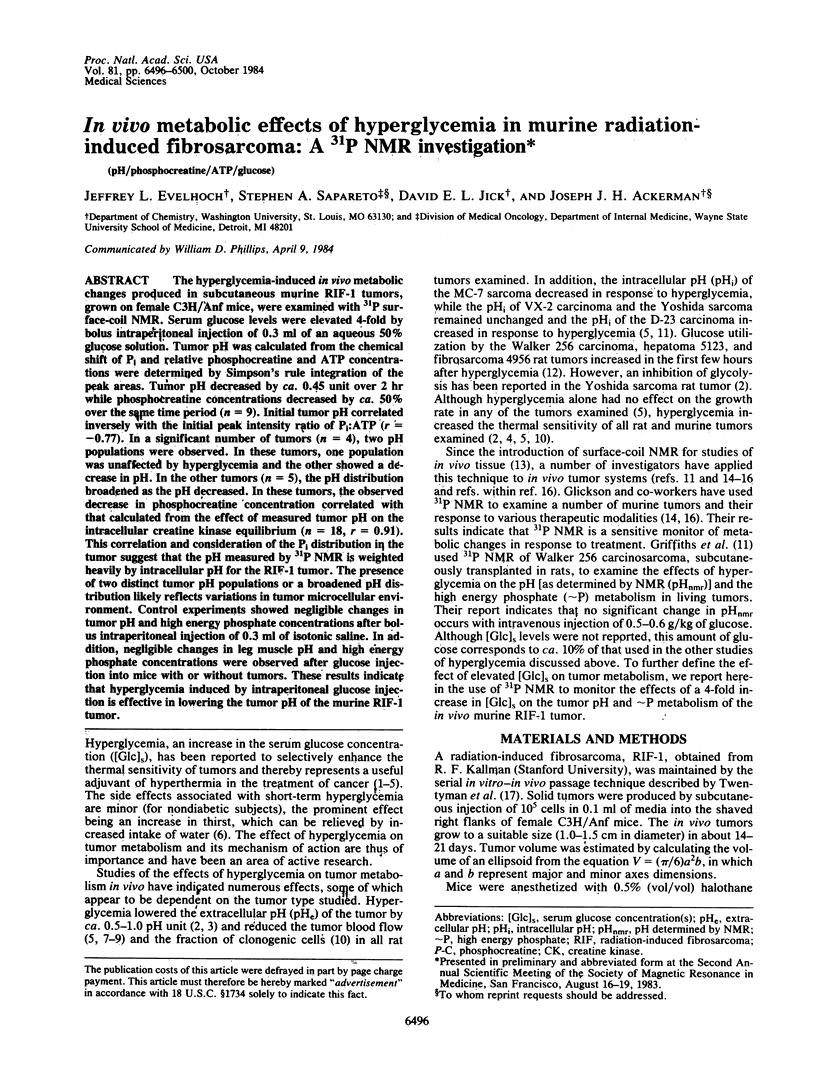
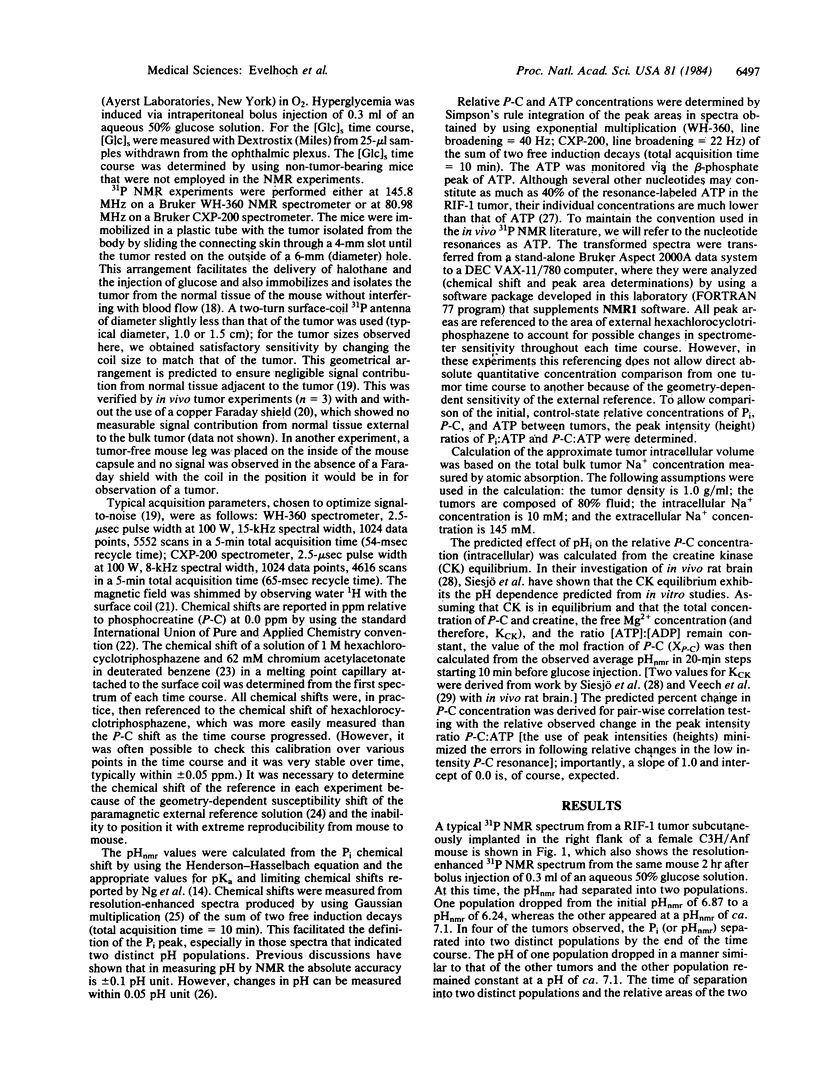
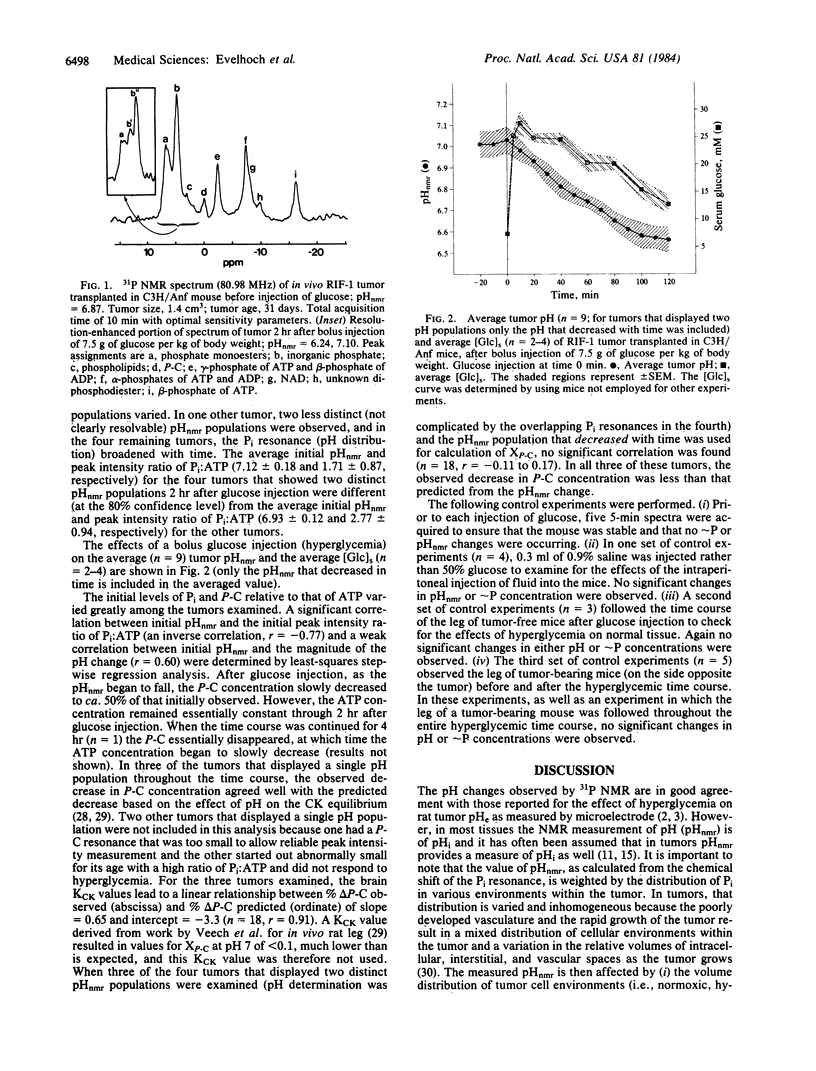
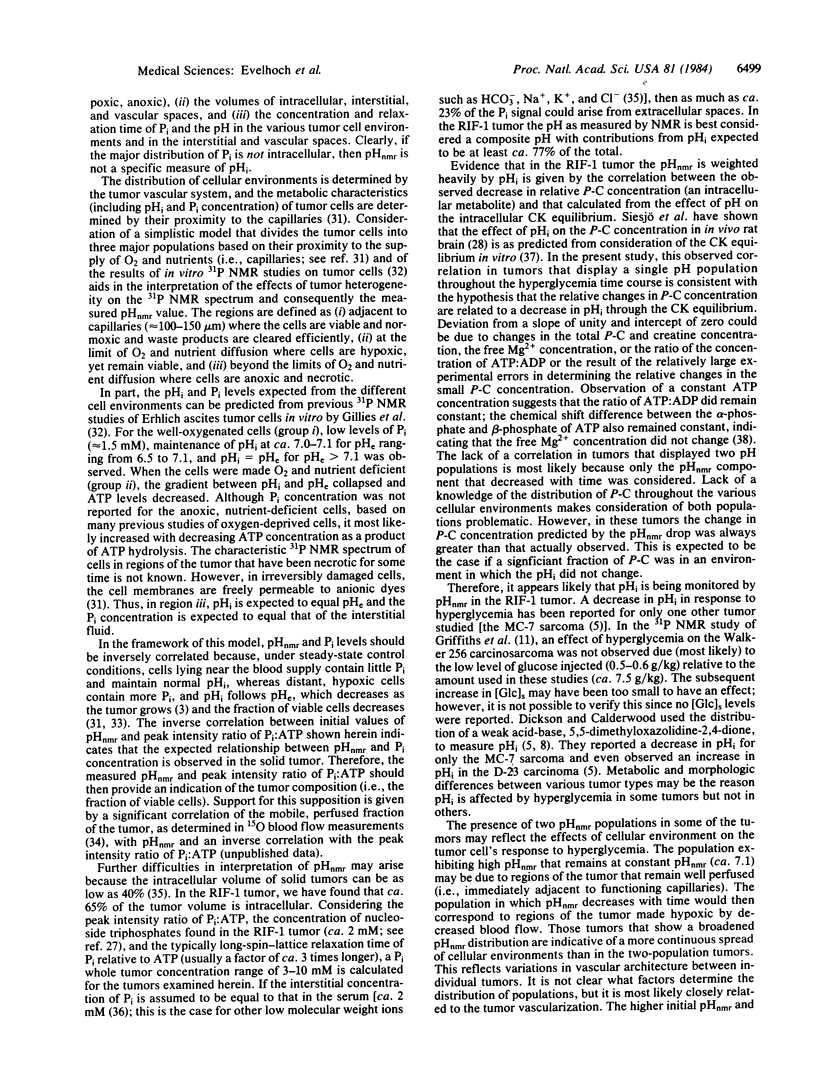
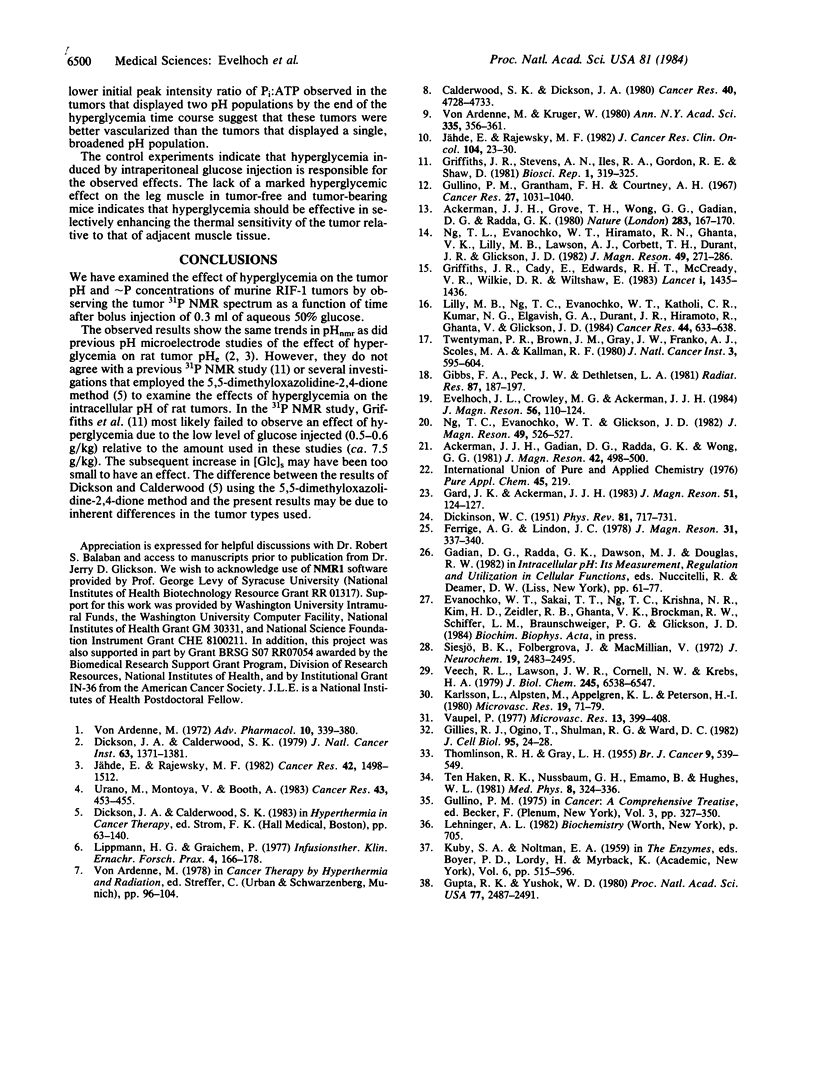
Selected References
These references are in PubMed. This may not be the complete list of references from this article.
- Ackerman J. J., Grove T. H., Wong G. G., Gadian D. G., Radda G. K. Mapping of metabolites in whole animals by 31P NMR using surface coils. Nature. 1980 Jan 10;283(5743):167–170. doi: 10.1038/283167a0. [DOI] [PubMed] [Google Scholar]
- Calderwood S. K., Dickson J. A. Effect of hyperglycemia on blood flow, pH, and response to hyperthermia (42 degrees) of the Yoshida sarcoma in the rat. Cancer Res. 1980 Dec;40(12):4728–4733. [PubMed] [Google Scholar]
- Dickson J. A., Calderwood S. K. Effects of hyperglycemia and hyperthermia on the pH, glycolysis, and respiration of the Yoshida sarcoma in vivo. J Natl Cancer Inst. 1979 Dec;63(6):1371–1381. [PubMed] [Google Scholar]
- Gibbs F. A., Jr, Peck J. W., Dethlefsen L. A. The importance of intratumor temperature uniformity in the study of radiosensitizing effects of hyperthermia in vivo. Radiat Res. 1981 Jul;87(1):187–197. [PubMed] [Google Scholar]
- Gillies R. J., Ogino T., Shulman R. G., Ward D. C. 31P nuclear magnetic resonance evidence for the regulation of intracellular pH by Ehrlich ascites tumor cells. J Cell Biol. 1982 Oct;95(1):24–28. doi: 10.1083/jcb.95.1.24. [DOI] [PMC free article] [PubMed] [Google Scholar]
- Griffiths J. R., Cady E., Edwards R. H., McCready V. R., Wilkie D. R., Wiltshaw E. 31P-NMR studies of a human tumour in situ. Lancet. 1983 Jun 25;1(8339):1435–1436. doi: 10.1016/s0140-6736(83)92375-9. [DOI] [PubMed] [Google Scholar]
- Griffiths J. R., Stevens A. N., Iles R. A., Gordon R. E., Shaw D. 31P-NMR investigation of solid tumours in the living rat. Biosci Rep. 1981 Apr;1(4):319–325. doi: 10.1007/BF01114871. [DOI] [PubMed] [Google Scholar]
- Gullino P. M., Grantham F. H., Courtney A. H. Glucose consumption by transplanted tumors in vivo. Cancer Res. 1967 Jun;27(6):1031–1040. [PubMed] [Google Scholar]
- Gupta R. K., Yushok W. D. Noninvasive 31P NMR probes of free Mg2+, MgATP, and MgADP in intact Ehrlich ascites tumor cells. Proc Natl Acad Sci U S A. 1980 May;77(5):2487–2491. doi: 10.1073/pnas.77.5.2487. [DOI] [PMC free article] [PubMed] [Google Scholar]
- Jähde E., Rajewsky M. F. Sensitization of clonogenic malignant cells to hyperthermia by glucose-mediated, tumor-selective pH reduction. J Cancer Res Clin Oncol. 1982;104(1-2):23–30. doi: 10.1007/BF00402050. [DOI] [PubMed] [Google Scholar]
- Jähde E., Rajewsky M. F. Tumor-selective modification of cellular microenvironment in vivo: effect of glucose infusion on the pH in normal and malignant rat tissues. Cancer Res. 1982 Apr;42(4):1505–1512. [PubMed] [Google Scholar]
- Karlsson L., Alpsten M., Appelgren K. L., Peterson H. I. Intratumor distribution of vascular and extravascular spaces. Microvasc Res. 1980 Jan;19(1):71–79. doi: 10.1016/0026-2862(80)90084-9. [DOI] [PubMed] [Google Scholar]
- Lilly M. B., Ng T. C., Evanochko W. T., Katholi C. R., Kumar N. G., Elgavish G. A., Durant J. R., Hiramoto R., Ghanta V., Glickson J. D. Loss of high-energy phosphate following hyperthermia demonstrated by in vivo 31P-nuclear magnetic resonance spectroscopy. Cancer Res. 1984 Feb;44(2):633–638. [PubMed] [Google Scholar]
- Siesjö B. K., Folbergrová J., MacMillan V. The effect of hypercapnia upon intracellular pH in the brain, evaluated by the bicarbonate-carbonic acid method and from the creatine phosphokinase equilibrium. J Neurochem. 1972 Nov;19(11):2483–2495. doi: 10.1111/j.1471-4159.1972.tb01308.x. [DOI] [PubMed] [Google Scholar]
- THOMLINSON R. H., GRAY L. H. The histological structure of some human lung cancers and the possible implications for radiotherapy. Br J Cancer. 1955 Dec;9(4):539–549. doi: 10.1038/bjc.1955.55. [DOI] [PMC free article] [PubMed] [Google Scholar]
- Ten Haken R. K., Nussbaum G. H., Emami B., Hughes W. L. Photon activation-15O decay studies of tumor blood flow. Med Phys. 1981 May-Jun;8(3):324–336. doi: 10.1118/1.594835. [DOI] [PubMed] [Google Scholar]
- Twentyman P. R., Brown J. M., Gray J. W., Franko A. J., Scoles M. A., Kallman R. F. A new mouse tumor model system (RIF-1) for comparison of end-point studies. J Natl Cancer Inst. 1980 Mar;64(3):595–604. [PubMed] [Google Scholar]
- Urano M., Montoya V., Booth A. Effect of hyperglycemia on the thermal response of murine normal and tumor tissues. Cancer Res. 1983 Feb;43(2):453–455. [PubMed] [Google Scholar]
- Vaupel P. Hypoxia in neoplastic tissue. Microvasc Res. 1977 May;13(3):399–408. doi: 10.1016/0026-2862(77)90106-6. [DOI] [PubMed] [Google Scholar]
- Veech R. L., Lawson J. W., Cornell N. W., Krebs H. A. Cytosolic phosphorylation potential. J Biol Chem. 1979 Jul 25;254(14):6538–6547. [PubMed] [Google Scholar]
- von Ardenne M., Krüger W. The use of hyperthermia within the frame of cancer multistep therapy. Ann N Y Acad Sci. 1980;335:356–361. doi: 10.1111/j.1749-6632.1980.tb50760.x. [DOI] [PubMed] [Google Scholar]
- von Ardenne M. Selective multiphase cancer therapy: conceptual aspects and experimental basis. Adv Pharmacol Chemother. 1972;10:339–380. doi: 10.1016/s1054-3589(08)60527-x. [DOI] [PubMed] [Google Scholar]


